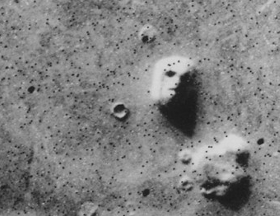Cognition
Seeing an Illusion: The Face That Isn't a Face
Patterns are everywhere, but some are illusory.
Posted April 12, 2022 Reviewed by Abigail Fagan
Key points
- When we encounter a lot of data, random details sometimes cluster together to form patterns that we recognize.
- Differentiating between illusory and causal patterns is essential to make decisions with the right expectations.
- One trick to avoid any illusions would be to challenge our immediate intuition and look for disconfirming evidence.

While circling Mars in 1976, NASA’s Viking 1 spacecraft took pictures of its surface. One image created quite a bit of controversy: It’s impossible not to immediately see the pattern on the image. It’s right there.
The “Face on Mars” created much speculation about aliens and extraterrestrial life on the red planet. People thought there must be a reason why that face exists and keeps looking at us.
Multiple Faces of Clustering Illusion
When there’s a lot of data, random details sometimes cluster together to form patterns that we recognize. It’s not that we see things that don’t exist. There’s indeed a shape of a face there. It’s just that it was formed randomly.
Randomness can generate many easily detectable patterns. If I tossed a coin thousands of times, we’d possibly observe streaks of 10 heads or tails in a row. But that wouldn’t mean that I have some special coin tossing powers.
The problem is that, while it may be easy to dismiss clusters on Mars and in coin tosses as random, it’s not at all easy to make that claim as confidently in many complicated situations we encounter.
Seeing Patterns Everywhere
We have access to a lot of information about a wide range of phenomena that happen every day. We observe businesses, stock performances, disasters, innovations, news from all over the world, and streams of opinions expressed in tweets, videos, and articles. These give us the opportunity to perceive countless patterns on which to base our decisions. And beyond our brains, we also have machines that further help us detect them, virtually everywhere.
Which of these patterns are in our control? Which can we predict with accuracy? Which are mainly random? Knowing these answers is essential to make decisions with the right expectations.
Looking for Disconfirming Evidence
Given that we typically interpret things in ways that fit our prior beliefs and personal preferences, one trick to avoid any illusions would be to challenge our immediate answers to these questions and look for reliable evidence to the contrary.
- If we intuitively think that randomness has a large role in some outcomes, we should check for valid analyses that identify potential causes.
- If we are convinced about certain specific reasons causing some outcomes, we should strive to assess and acknowledge the possible role of randomness.
When making decisions, such an approach would give us a clearer view about which patterns actually exist, and which are likely to be illusory.


